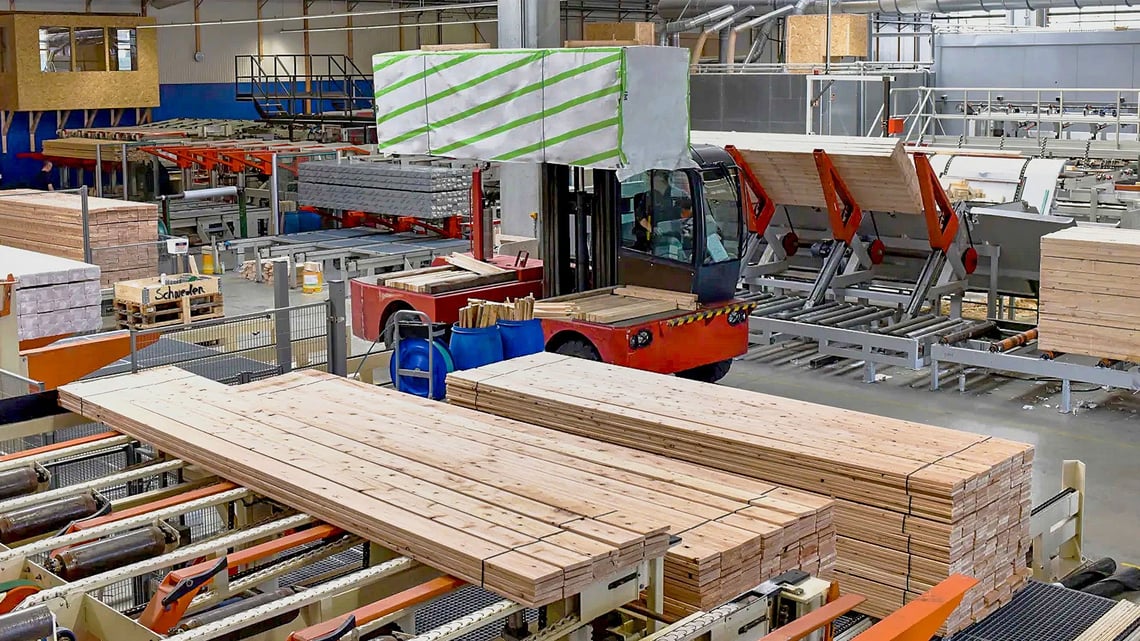
11 14 2019 | Fire protection | Fire regulations

11 14 2019 | Fire protection | Fire regulations
As demand for fire protected wood products grows, manufacturers should look to invest in solutions that can guarantee both the even quality of the fire protection and cost-effective production. A wide variety of skills and knowledge are required for the industrial fire protection of wooden panels, as the material is natural and organic. Close collaboration with the producer of the fire retardant will help optimise the process and meet CE marking requirements.
Installation-ready products speed up construction. This advantage shows in the increasing demand for prefabricated elements and panels surface-treated at the factory, for example. This category also includes fire protected and installation-ready interior and exterior panels.
Wood products can be fire protected by covering their surface in a fire-retardant paint or a translucent, optionally tinted impregnating compound that leaves the grain of the wood visible. These solutions differ mostly in the appearance and treatment process of the products. There may also be differences in indoor emissions and resistance to weather, for example.
In building and construction, the natural appearance of wood is usually preferable to preserve. This is why designers tend to choose wood products treated with a translucent fire retardant. These translucent fire retardants can be colourless or tinted. Paints are used when the grain of the wood needs to be concealed.
The fire retardant's type is a major factor in the treatment process. In addition to the type and the duration of production runs, the cost-effectiveness of the process is also affected by the various substances used and the number of treatment and transitional drying stages required – in other words, the total time necessary to complete the fire protection. Any treatments applied at the worksite are a relevant part of the total cost, in particular for the end customer.
Generally speaking, three different substances are applied in a covering fire protection paint system: the first is a fungicide, the second is the expanding fire retardant paint, and the last is a surface layer of paint with the desired colour that improves weathering performance. The product is dried between each stage and the production line is carefully cleaned. The fire protection of these products may not meet the requirements of the construction site and may require a final fourth treatment during or soon after installation.
It can be challenging to evaluate the functionality and conformance of these paint systems, as the final amount of product used may not be indicated by the final product's CE marking information.
Translucent fire retardants simplify the industrial production process. Although the number of treatment stages increases, the same substance is used at every stage, and the production line does not need to be cleaned between stages. In addition, non-toxic and water-soluble fire retardants, such as NT DECO, only require workers to use regular protective equipment. Both the fire retardants and the final fire protected products can be stored in normal ventilated storage facilities. The production line is cleaned with water. The pH-neutral fire retardants do not corrode production equipment.
Certified fire protection of exterior and interior panelling to fire class B-s1, d0 with a translucent fire retardant, such as NT DECO, makes them fully installation-ready wood products – the only processing required on-site is the treatment of any cut panel ends. The actual amount of product used and the resulting fire class are simple to verify from the product's CE marking information.
Typically, wood products industrially fire protected with NT DECO are made of spruce, larch, or cedar. These wood species behave identically in industrial fire protection.
In industrial fire protection, translucent fire retardants are commonly applied by using a vacuum impregnation or brushing method. If a tinted fire retardant is used, it must be mixed thoroughly before use. This ensures an even distribution of the pigment in the fire retardant and an even hue across the product.
For fire class B-s1, d0, the required amount of fire retardant is 350 g/m2. Consecutive treatments are required to impregnate the wood to a depth of 3-5 mm across all four sides of each piece. The number of treatment stages varies by the method used and the quality of the panel's surface.
Vacuum impregnation lines are highly effective, as they can treat all four sides simultaneously. Brushing lines can treat three sides in one pass, meaning that the pieces must be rotated to treat all the sides. This results in double the number of treatment stages compared to vacuum impregnation lines.
Fine-sawn spruce panels, particularly used for exterior cladding, generally require three consecutive treatments, as their rough surface will absorb approximately 120 g/m2 of the fire retardant. Surfaced panels used for interior panelling require four to six treatments, as a smooth surface will only absorb 60 to 90 g/m2. To account for this, some lines will sand down the surfaces or roughen them with steel brushes prior to fire protection.
The wood may have a maximum moisture content of 18 per cent. The amount of fire retardant absorbed in the wood is verified by weighing the product after each treatment. Between treatments, the surfaces are either dried rapidly in an in-line infrared furnace or for two hours in the production facility for even absorption. The best result is achieved with an ultraviolet drying process after the last treatment, or if the products can be left to breathe before they are stacked and packed.
Close collaboration with the producer of the fire retardant is important to maximise production efficiency and eliminate errors. Fire protected wood products must be CE-marked and meet the fire class requirements of their on-site application.
Nordtreat is a responsible producer of fire retardants – our products are comprehensively tested and certified for both reaction to fire and indoor emissions. In addition, the treatment methods of common panel thicknesses have been tested, documented, and certified for different wood species. For example, this certification includes spruce, larch, and cedar panels and boards over 20 mm thick and certified for fire class B-s1, d0.
Wood product manufacturers and treatment providers can use the classification reports to carry out trial runs and prepare documentation for production, as well as apply fo CE marking certification for the treated products. Nordtreat will be happy to assist with the completion of the process.

Keep on track about fire safety of wood products. Our newsletter provides you with the latest ideas and solutions.

